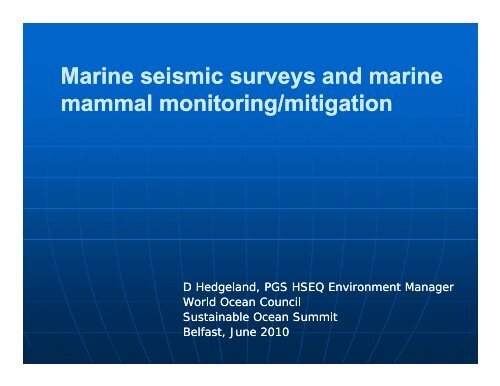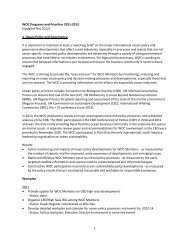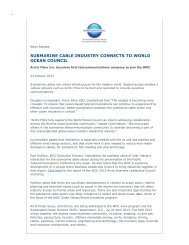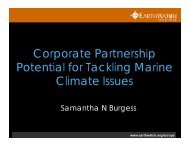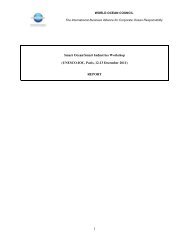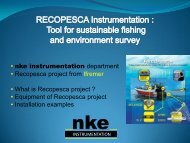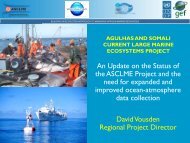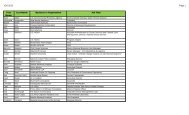David Hedgeland - World Ocean Council
David Hedgeland - World Ocean Council
David Hedgeland - World Ocean Council
Create successful ePaper yourself
Turn your PDF publications into a flip-book with our unique Google optimized e-Paper software.
Marine seismic i surveys and marine<br />
mammal monitoring/mitigation<br />
D <strong>Hedgeland</strong>, PGS HSEQ Environment Manager<br />
<strong>World</strong> <strong>Ocean</strong> <strong>Council</strong><br />
Sustainable <strong>Ocean</strong> Summit<br />
Belfast, June 2010
Outline<br />
• Marine seismic surveys<br />
• Marine mammal monitoring i and<br />
mitigation activities<br />
• Passive Acoustic Monitoring
Marine seismic surveys - 2D vs 3D<br />
A<br />
B<br />
A<br />
B
2D vs 3D Source effort vs streamer count<br />
Source array<br />
Streamer array<br />
Seabed<br />
Single source/single streamer<br />
1 subsurface line<br />
Dual source/dual streamer<br />
4 subsurface lines<br />
Seabed<br />
Dual source/4 streamer<br />
8 subsurface lines<br />
Dual source/6 streamer<br />
12 subsurface lines<br />
Dual source/10-12 streamer<br />
20-24 subsurface u lines
Photos courtesy of PGS<br />
Vessel<br />
Source<br />
Streamers
Google Earth/streamers<br />
Harbour Commissioners<br />
2010 1990 -- dual source/>12x6km source/3x3km streamers<br />
In-sea equipment<br />
Subsurface coverage Googlemaps
Marine mammal monitoring and mitigation<br />
activities<br />
iti<br />
• Regulatory legislation varies greatly between geographic<br />
regions<br />
• Precaution based approach<br />
• Varying levels of scientific research<br />
• Common sense<br />
• Generic measures<br />
• Pre-survey<br />
planning and permitting<br />
• “soft-start” start” source procedures<br />
• Exclusion zones<br />
• Marine mammal (visual and acoustic) monitoring<br />
• Approach criteria
Towed Passive Acoustic Monitoring (PAM)<br />
• Listening for cetacean vocalisations and estimate position<br />
• Dedicated towed hydrophone/recording system (fixed<br />
installations tion also available)<br />
• Depth transducers but NO positional control<br />
• Guard or seismic vessel deployment<br />
In-sea<br />
Towing platform Onboard PC/laptop, user<br />
hydrophone<br />
processing interface-display<br />
streamer hardware software<br />
PAM<br />
operator
Industry operational experience<br />
• Availability of experienced PAM operators is significantly<br />
limited with the broad combination of skills required in the<br />
field<br />
• marine mammal bioacoustics<br />
• underwater sound<br />
• hardware/software engineering<br />
• seismic operations (particularly with regard to safety).<br />
• Different PAM software tools provide varying levels of<br />
integration between detection and logging g systems<br />
• limited number of personnel that are familiar with any one<br />
software application.<br />
• Need for consistent and reliable user interface<br />
• Need trained and experienced personnel
Towed Passive Acoustic Monitoring (PAM)<br />
In-sea<br />
hydrophone<br />
streamer<br />
Towing platform<br />
Onboard<br />
processing<br />
hardware<br />
PC/laptop, user<br />
interface-display<br />
software<br />
PAM<br />
operator
Further information<br />
www.iagc.org


